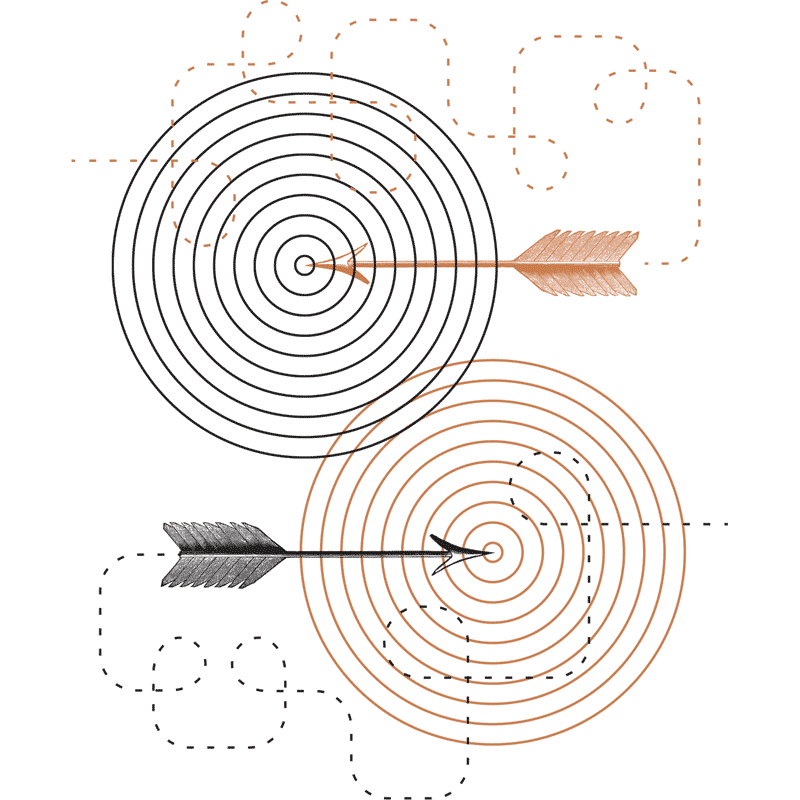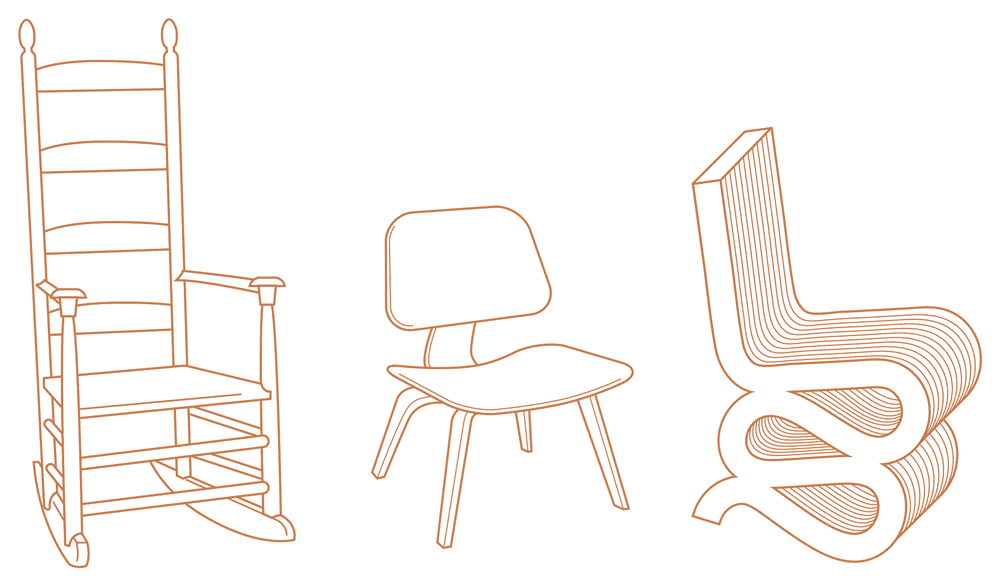
Chapter Six Context and Response
We sail within a vast sphere, ever drifting in uncertainty, driven from end to end. When we think to attach ourselves to any point and to fasten to it, it wavers and leaves us; and if we follow it, it eludes our grasp, slips past us, and vanishes for ever. Nothing stays for us. Blaise Pascal
The tightrope walker finds his balance by keeping his momentum. If he stands still, he will fall; if he locks up his limbs, he will throw his balance off. He stays on the wire by moving in response, swinging his arms up and down, and steadily setting one foot in front of the other. Like him, there are no fixed points in our design work, no opportunities to stop and hold still. We must respond and move, simply because the work moves and the space around design shifts as culture changes and the adjacent possible grows. Design is always in motion; we either sway with it or we get thrown off the line.
The responsive creativity that design requires is similar to what installation artist Robert Irwin started to do with his art in the 1970s. Irwin would make no formal plans before arriving at the gallery where his work was to be shown. Instead, he’d walk into the room and spend a great deal of time observing the qualities of the space, assessing the shape of the room, and judging its light. He would then devise a plan and conceptualize the art based on his observations. The art he produced was a direct response to the context of his work. The space became his material; each piece was an ad hoc exploration.
Sometimes the space would suggest more grandiose pieces, like his installation at the San Diego Museum of Contemporary Art, where Irwin filled a large wall with fluorescent lights organized into interlocking modules shaped like Tetris pieces. Other rooms called for more minimal tactics, like his piece at the Museum of Modern Art in New York, where he merely changed the fluorescent lighting by alternating cool and warm bulbs, stretching a piece of scrim below the lights like a second ceiling, and stringing wire across the length of the room at eye level to prevent the viewer’s eyes from focusing.
In either case, Irwin’s process is to show up and let the context speak what it requires to him. The relationship Irwin has with the space reminds me of a few conversations I’ve had with portrait photographers about their work. One of the points that frequently comes up is that the majority of their job is to wait for the person to reveal their true self so that they can make an accurate portrait of their subject. The process is mostly waiting, more like listening than speaking, and most photographers say that the best shots come at the end of the session, because earlier exposures always feel rigid and false. The subject’s guard is still up, but eventually, their true face emerges for the camera.
The necessities and influence of subject and context, whether in portraiture, installation, or design, take time to unfold. It is the designer’s job to figure out a way to have a problem show its actual self so that he can respond to the truth that has emerged. Getting to know a problem is a bit like getting to know a person: it’s a gradual process that requires patience, and there is no state of completion. You can never know the full of a problem, because there is never comprehensive information available. You have to simply draw the line somewhere and make up the rest as you go along. Irwin describes his process, saying, “I took to waiting for the world to tell me so that I could respond.… Intuition replaced logic. I just attended to the circumstances, and after weeks and weeks of observation, of hairline readjustments, the right solution would presently announce itself.”
In other words, Irwin’s process begins by listening: to the room, his intuition, and the work as he is making it. He then enters a dialogue with the space, going near and far just like the painter in the studio. Irwin’s gaze, however, also contains the space around his work and how his piece relates to its context. His process favors field-testing on-site by improvising in response to the context. He summons a more human metric to forecast decisions by using instinct instead of logic. Logical thinking has a tendency to break when all the parts are moving, so Irwin speculates with his gut, makes a modification, then tests it with his eyes.
The physical forms of Irwin’s work are not the emphasis of his practice. They are only meant to collaborate with the space and not intended to have any sort of significance themselves. I think this pattern also fits with the way that design operates: the products of design are just the means to an end. They are objects whose existence is rooted in the need that they serve. The primary purpose of the design is to have it do something particular, not be any particular thing. All of this implies that design is a field of outcomes and consequences more than one of artifacts. The forms that designers produce are flexible, so long as the results serve the need.
Let me give an example. Suppose I sent a design brief to a few designers asking them to design a chair. What might I get back?

Left: Traditional Shaker Chair, 1860s
Center: Molded Plywood Lounge Chair, The Eames Office, 1946
Right: Wiggle Chair, Frank Gehry, 1972
We have a multiplicity of chairs from three different designers: a tall rocking chair from the Shakers, a bent plywood seat from the Eames Office, and a curved chair made of cardboard by Frank Gehry. There are certain similarities and patterns in the chairs, because the objectives of the work act as a constraint on the process. They guide the designer to certain inevitable conclusions which are necessary to have the design fill the need it seeks to serve. Each chair has a seat, all form a cradle for the sitter, and all the chairs are of similar size that is based on the proportions of the human body. The constants of the designs are determined by the unavoidable logistical issues that must be addressed to make the design useful. A chair, for instance, must follow certain proportions to comfortably hold a human body.
But the three chairs clearly have differences in structure and style. Multiplicity will always crop up with design, even in spite of constraints, because the work is subjective and without fixed solutions. The products of design are more negotiations of issues and responses to problems than absolute, fixed solutions, and this provides plenty of space for different takes and perspectives. Grouping the chairs together makes it evident that each design is an attempt to fill the need of sitting seen through the lens of each designer’s disposition. Their responses are a negotiation of the problem with its context, and the designers are a part of that context.
The success of one design, however, does not suggest that the others are less useful or not as good. Design can have diversity in its solutions to problems without compromising the success of any of them. One approach does not negate the quality of another, so the comfort of a Shaker chair does not imply that the other two are uncomfortable simply because they are different. Gehry’s cardboard chair, for instance, has no legs, but legs are only necessary to support the seat at a proper height. Gehry was able to scrap them because he found a different way to lift the seat.
Our chairs differ because of the dispositions of their makers, but also because they were made at various times in different cultures. Time and place have a large impact on the products of design, because they dictate what is possible. A Shaker, for instance, could not have created the Eames’ chair, because plywood did not exist, never mind the technology to bend the wood. The adjacent possible had expanded in the one hundred years between the first Shaker chair and the Eames’ chair, which opened up new opportunities to rethink how chairs were made.
Culture also has an effect on the products of design. There is no guarantee that the Shakers would have found the Eames’ chair desirable to make, even if they had the technology needed to produce it. The relationship of design and culture presents another two-way bridge where influence goes both ways: culture creates design’s target by defining what is desirable. Simultaneously, the best design recalibrates what we think and how we feel about what surrounds us. The two shine on one another: culture changes what it expects from design after design changes culture, meaning that when our work hits the target, that target moves out from underneath it.
The shifting bullseye suggests that we should reconsider our conception of design as a problem-solving endeavor. Hitting the bullseye is only ever a temporary state, and rather than seeing that as a problem, we should pull another arrow from our quiver and celebrate the moving target as the way we inch toward better circumstances. We should embrace the subjective nature of what we do and allow for the multiplicity of responses to thrive, because the mixed pool represents the diversity of human perspective. That diversity fortifies us, makes us strong. Most of all, we should build movement into our definition of the craft and its successful outcomes. The best design acts as a form of loosely composed, responsive movement, and seeks to have all the adjacent elements sway together.
This is a generous definition, much greater than just problem solving, because the best design has to offer much more than making problems go away. Design can also build up good, desirable artifacts, experiences, and situations that are additive forces in this world. It helps us live well by producing and elevating new kinds of value, such as engagement, participation, and happiness. These are design’s true outcomes, because the practice, at its root, is simply people making useful things for other people. It’s life-enhancement, and we can make it for one another, so long as we act responsively and keep our momentum moving forward, just like the man on the tightrope.
